Business Environment Analysis: McDonald's Report and Stakeholders
VerifiedAdded on 2020/06/06
|10
|2856
|52
Report
AI Summary
This report provides a comprehensive analysis of McDonald's business environment. It begins by defining different types of businesses, including public and private limited companies, and voluntary sectors, highlighting their purposes. The report then identifies and explains the various stakeholders that influence a business's objectives, such as owners, employees, unions, and customers. It further examines organizational structures, contrasting hierarchical and flat structures, and how McDonald's, as a public limited company, utilizes its hierarchical structure to fulfill its purpose. The report also explores the influence of contrasting economic environments, like recession and boom, on business activities, and analyzes how political, legal, and social factors impact business operations. The conclusion summarizes the key findings, emphasizing the importance of understanding the business environment for strategic decision-making and success.
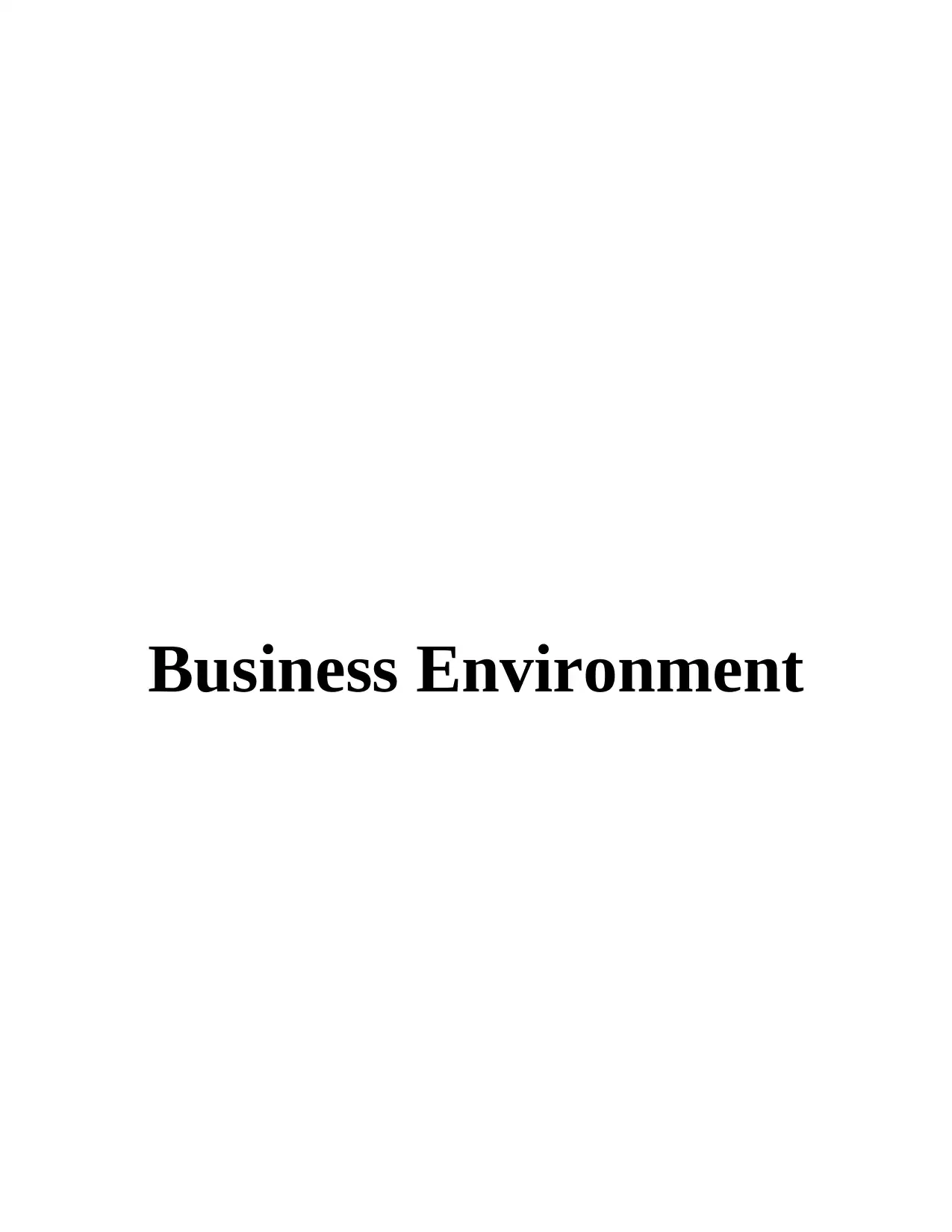
Business Environment
Paraphrase This Document
Need a fresh take? Get an instant paraphrase of this document with our AI Paraphraser
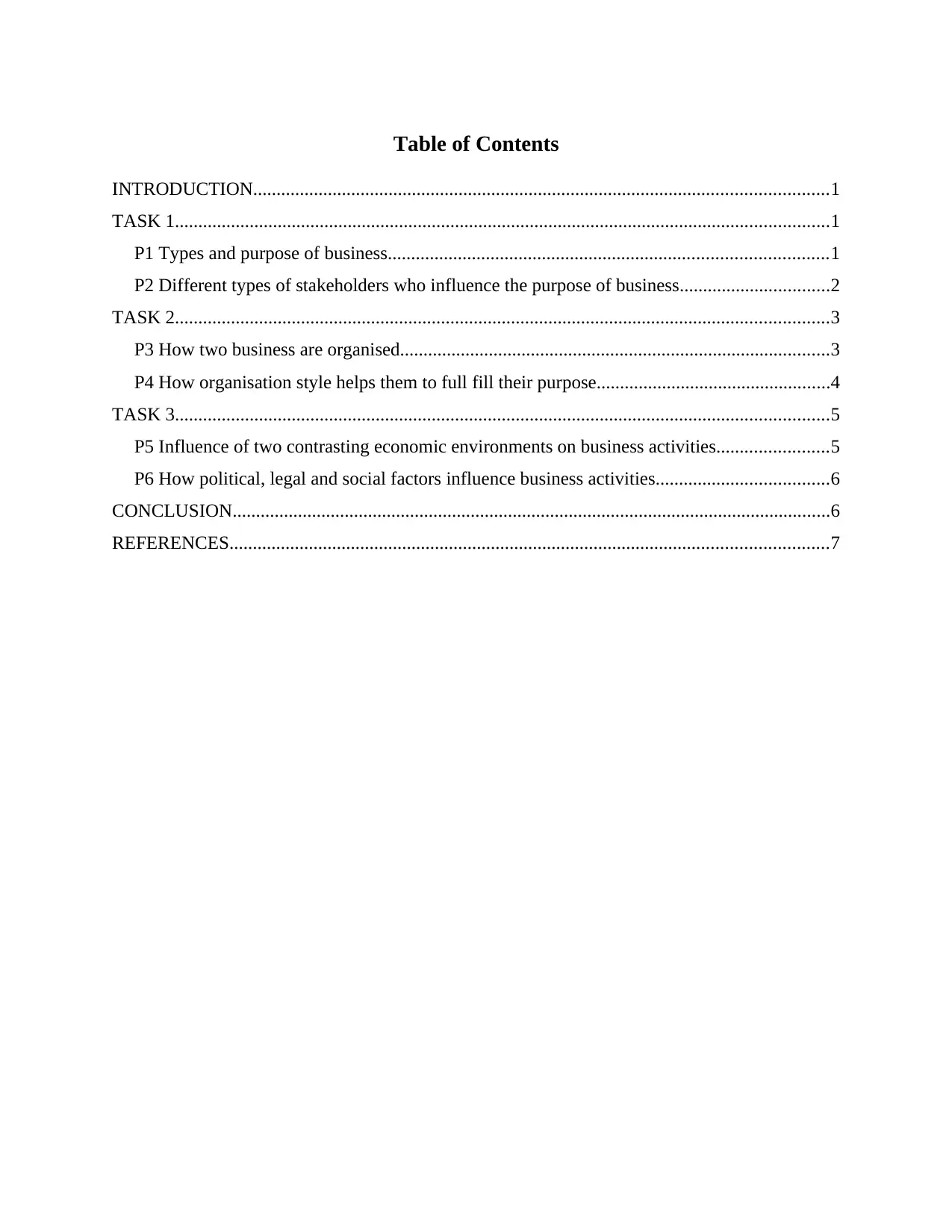
Table of Contents
INTRODUCTION...........................................................................................................................1
TASK 1............................................................................................................................................1
P1 Types and purpose of business..............................................................................................1
P2 Different types of stakeholders who influence the purpose of business................................2
TASK 2............................................................................................................................................3
P3 How two business are organised............................................................................................3
P4 How organisation style helps them to full fill their purpose..................................................4
TASK 3............................................................................................................................................5
P5 Influence of two contrasting economic environments on business activities........................5
P6 How political, legal and social factors influence business activities.....................................6
CONCLUSION................................................................................................................................6
REFERENCES................................................................................................................................7
INTRODUCTION...........................................................................................................................1
TASK 1............................................................................................................................................1
P1 Types and purpose of business..............................................................................................1
P2 Different types of stakeholders who influence the purpose of business................................2
TASK 2............................................................................................................................................3
P3 How two business are organised............................................................................................3
P4 How organisation style helps them to full fill their purpose..................................................4
TASK 3............................................................................................................................................5
P5 Influence of two contrasting economic environments on business activities........................5
P6 How political, legal and social factors influence business activities.....................................6
CONCLUSION................................................................................................................................6
REFERENCES................................................................................................................................7

⊘ This is a preview!⊘
Do you want full access?
Subscribe today to unlock all pages.

Trusted by 1+ million students worldwide
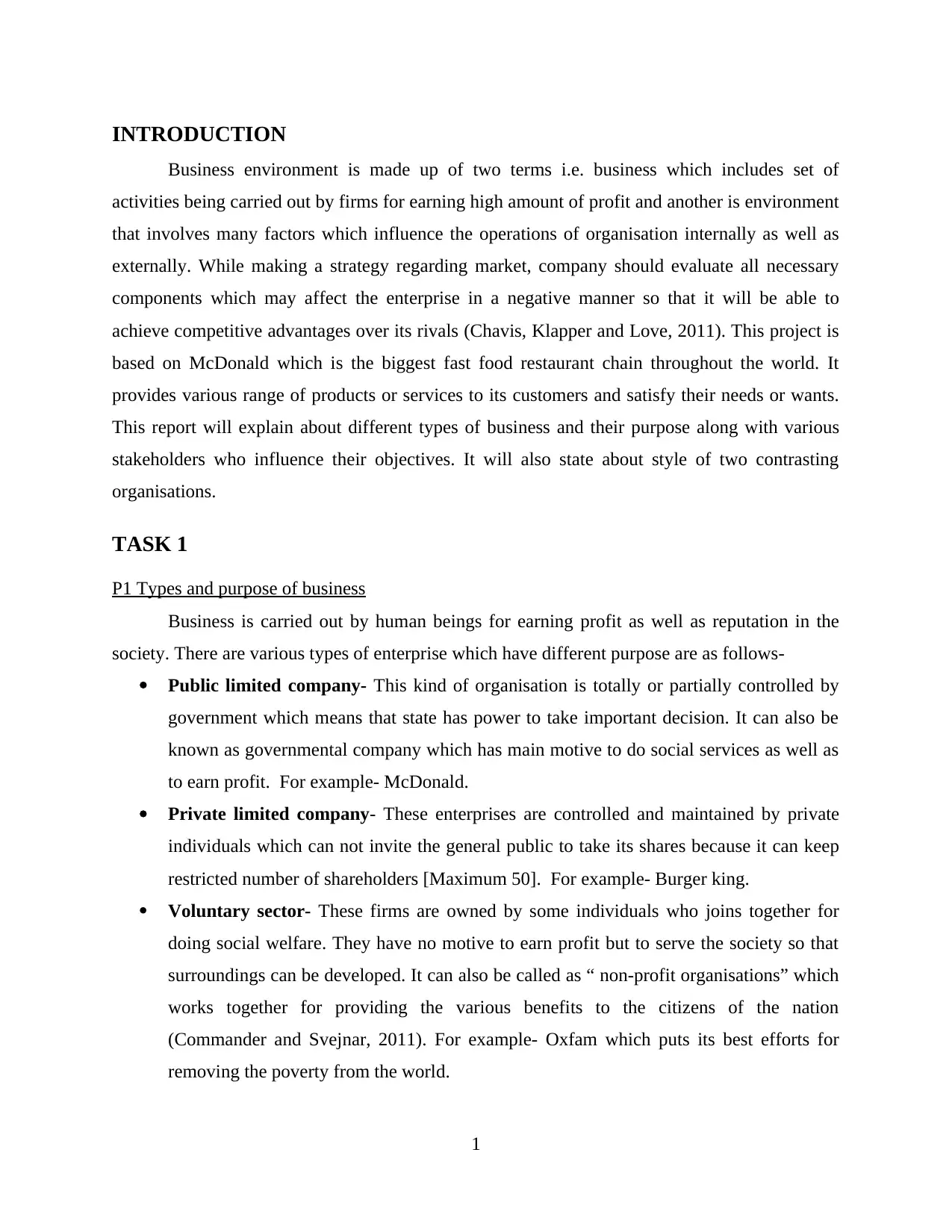
INTRODUCTION
Business environment is made up of two terms i.e. business which includes set of
activities being carried out by firms for earning high amount of profit and another is environment
that involves many factors which influence the operations of organisation internally as well as
externally. While making a strategy regarding market, company should evaluate all necessary
components which may affect the enterprise in a negative manner so that it will be able to
achieve competitive advantages over its rivals (Chavis, Klapper and Love, 2011). This project is
based on McDonald which is the biggest fast food restaurant chain throughout the world. It
provides various range of products or services to its customers and satisfy their needs or wants.
This report will explain about different types of business and their purpose along with various
stakeholders who influence their objectives. It will also state about style of two contrasting
organisations.
TASK 1
P1 Types and purpose of business
Business is carried out by human beings for earning profit as well as reputation in the
society. There are various types of enterprise which have different purpose are as follows-
Public limited company- This kind of organisation is totally or partially controlled by
government which means that state has power to take important decision. It can also be
known as governmental company which has main motive to do social services as well as
to earn profit. For example- McDonald.
Private limited company- These enterprises are controlled and maintained by private
individuals which can not invite the general public to take its shares because it can keep
restricted number of shareholders [Maximum 50]. For example- Burger king.
Voluntary sector- These firms are owned by some individuals who joins together for
doing social welfare. They have no motive to earn profit but to serve the society so that
surroundings can be developed. It can also be called as “ non-profit organisations” which
works together for providing the various benefits to the citizens of the nation
(Commander and Svejnar, 2011). For example- Oxfam which puts its best efforts for
removing the poverty from the world.
1
Business environment is made up of two terms i.e. business which includes set of
activities being carried out by firms for earning high amount of profit and another is environment
that involves many factors which influence the operations of organisation internally as well as
externally. While making a strategy regarding market, company should evaluate all necessary
components which may affect the enterprise in a negative manner so that it will be able to
achieve competitive advantages over its rivals (Chavis, Klapper and Love, 2011). This project is
based on McDonald which is the biggest fast food restaurant chain throughout the world. It
provides various range of products or services to its customers and satisfy their needs or wants.
This report will explain about different types of business and their purpose along with various
stakeholders who influence their objectives. It will also state about style of two contrasting
organisations.
TASK 1
P1 Types and purpose of business
Business is carried out by human beings for earning profit as well as reputation in the
society. There are various types of enterprise which have different purpose are as follows-
Public limited company- This kind of organisation is totally or partially controlled by
government which means that state has power to take important decision. It can also be
known as governmental company which has main motive to do social services as well as
to earn profit. For example- McDonald.
Private limited company- These enterprises are controlled and maintained by private
individuals which can not invite the general public to take its shares because it can keep
restricted number of shareholders [Maximum 50]. For example- Burger king.
Voluntary sector- These firms are owned by some individuals who joins together for
doing social welfare. They have no motive to earn profit but to serve the society so that
surroundings can be developed. It can also be called as “ non-profit organisations” which
works together for providing the various benefits to the citizens of the nation
(Commander and Svejnar, 2011). For example- Oxfam which puts its best efforts for
removing the poverty from the world.
1
Paraphrase This Document
Need a fresh take? Get an instant paraphrase of this document with our AI Paraphraser
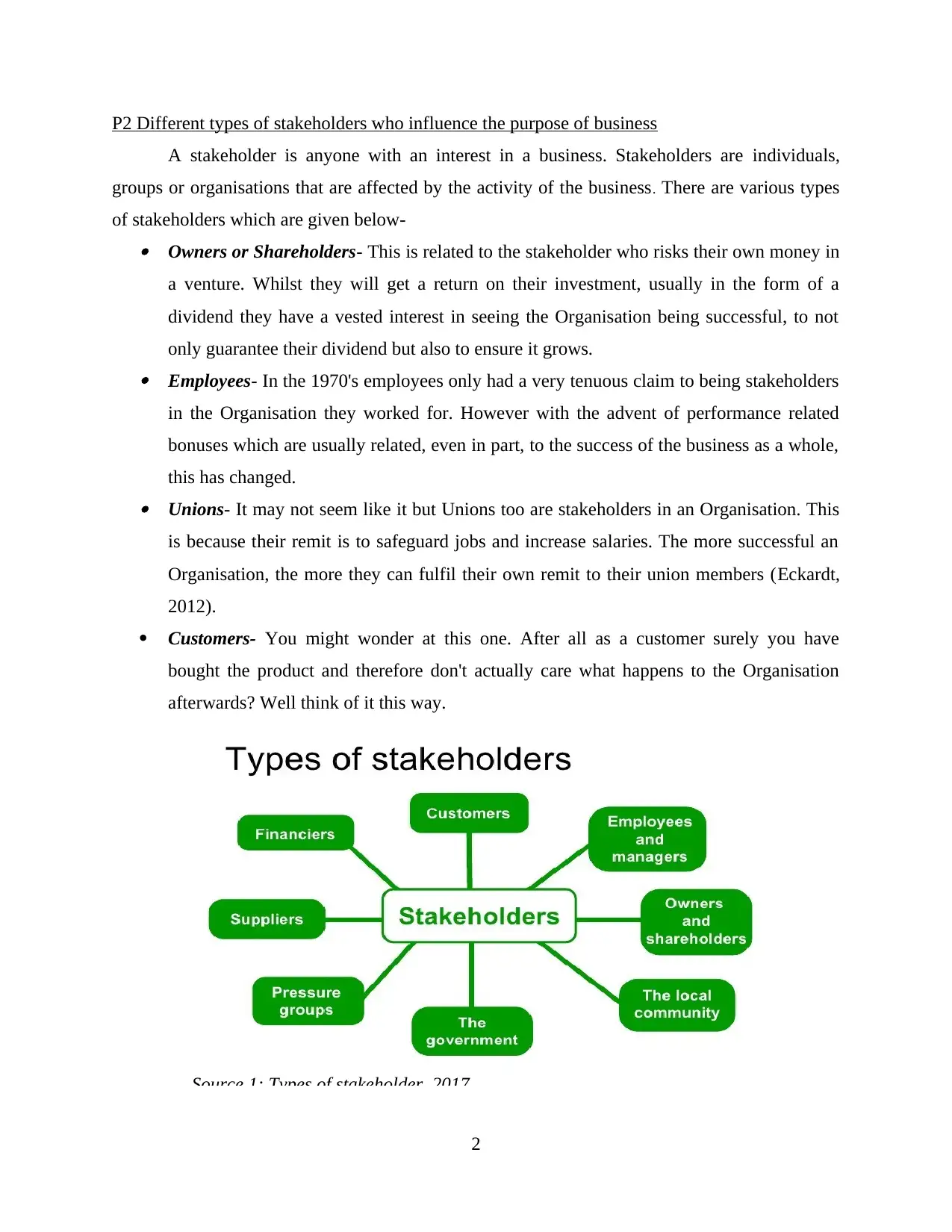
P2 Different types of stakeholders who influence the purpose of business
A stakeholder is anyone with an interest in a business. Stakeholders are individuals,
groups or organisations that are affected by the activity of the business. There are various types
of stakeholders which are given below- Owners or Shareholders- This is related to the stakeholder who risks their own money in
a venture. Whilst they will get a return on their investment, usually in the form of a
dividend they have a vested interest in seeing the Organisation being successful, to not
only guarantee their dividend but also to ensure it grows. Employees- In the 1970's employees only had a very tenuous claim to being stakeholders
in the Organisation they worked for. However with the advent of performance related
bonuses which are usually related, even in part, to the success of the business as a whole,
this has changed. Unions- It may not seem like it but Unions too are stakeholders in an Organisation. This
is because their remit is to safeguard jobs and increase salaries. The more successful an
Organisation, the more they can fulfil their own remit to their union members (Eckardt,
2012).
Customers- You might wonder at this one. After all as a customer surely you have
bought the product and therefore don't actually care what happens to the Organisation
afterwards? Well think of it this way.
2
Source 1: Types of stakeholder, 2017
A stakeholder is anyone with an interest in a business. Stakeholders are individuals,
groups or organisations that are affected by the activity of the business. There are various types
of stakeholders which are given below- Owners or Shareholders- This is related to the stakeholder who risks their own money in
a venture. Whilst they will get a return on their investment, usually in the form of a
dividend they have a vested interest in seeing the Organisation being successful, to not
only guarantee their dividend but also to ensure it grows. Employees- In the 1970's employees only had a very tenuous claim to being stakeholders
in the Organisation they worked for. However with the advent of performance related
bonuses which are usually related, even in part, to the success of the business as a whole,
this has changed. Unions- It may not seem like it but Unions too are stakeholders in an Organisation. This
is because their remit is to safeguard jobs and increase salaries. The more successful an
Organisation, the more they can fulfil their own remit to their union members (Eckardt,
2012).
Customers- You might wonder at this one. After all as a customer surely you have
bought the product and therefore don't actually care what happens to the Organisation
afterwards? Well think of it this way.
2
Source 1: Types of stakeholder, 2017
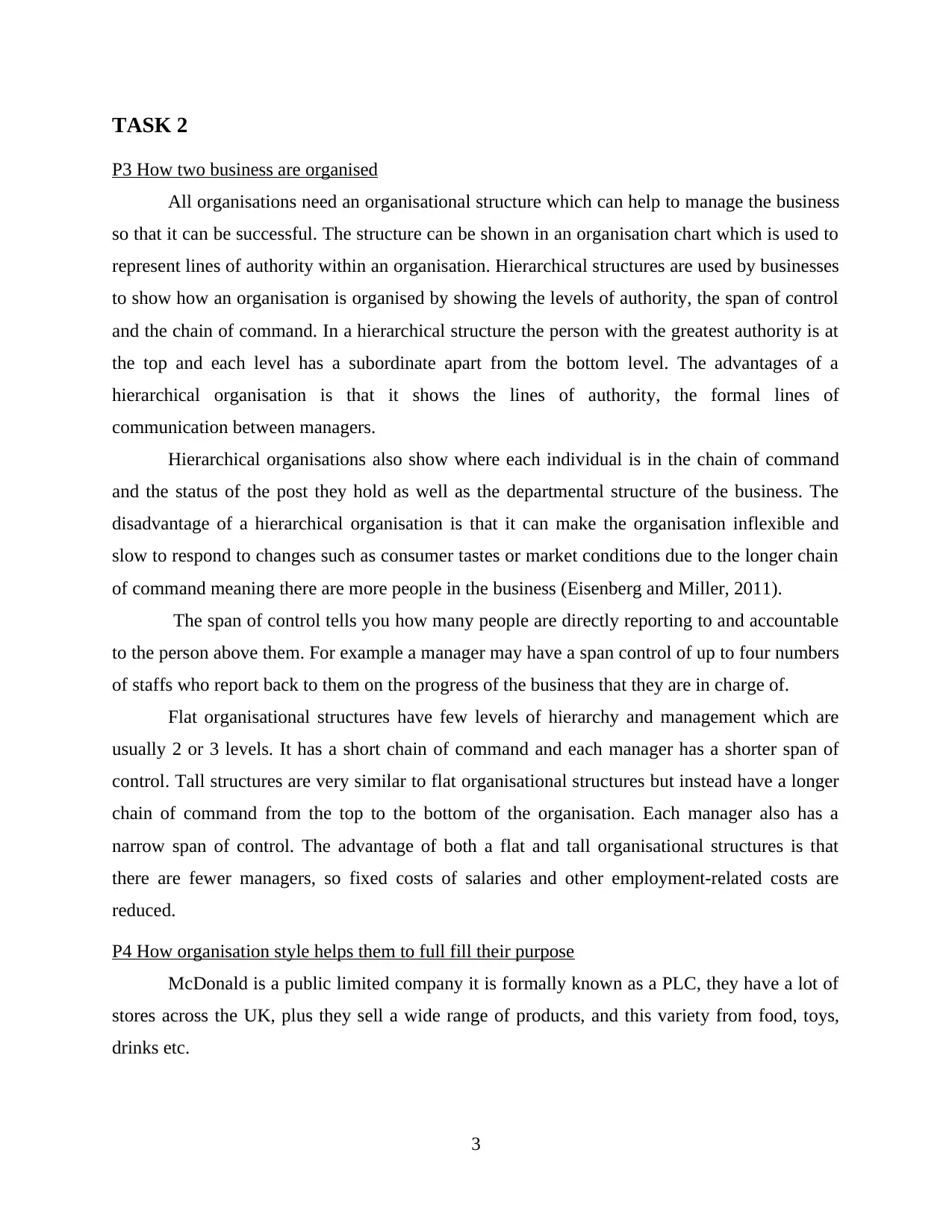
TASK 2
P3 How two business are organised
All organisations need an organisational structure which can help to manage the business
so that it can be successful. The structure can be shown in an organisation chart which is used to
represent lines of authority within an organisation. Hierarchical structures are used by businesses
to show how an organisation is organised by showing the levels of authority, the span of control
and the chain of command. In a hierarchical structure the person with the greatest authority is at
the top and each level has a subordinate apart from the bottom level. The advantages of a
hierarchical organisation is that it shows the lines of authority, the formal lines of
communication between managers.
Hierarchical organisations also show where each individual is in the chain of command
and the status of the post they hold as well as the departmental structure of the business. The
disadvantage of a hierarchical organisation is that it can make the organisation inflexible and
slow to respond to changes such as consumer tastes or market conditions due to the longer chain
of command meaning there are more people in the business (Eisenberg and Miller, 2011).
The span of control tells you how many people are directly reporting to and accountable
to the person above them. For example a manager may have a span control of up to four numbers
of staffs who report back to them on the progress of the business that they are in charge of.
Flat organisational structures have few levels of hierarchy and management which are
usually 2 or 3 levels. It has a short chain of command and each manager has a shorter span of
control. Tall structures are very similar to flat organisational structures but instead have a longer
chain of command from the top to the bottom of the organisation. Each manager also has a
narrow span of control. The advantage of both a flat and tall organisational structures is that
there are fewer managers, so fixed costs of salaries and other employment-related costs are
reduced.
P4 How organisation style helps them to full fill their purpose
McDonald is a public limited company it is formally known as a PLC, they have a lot of
stores across the UK, plus they sell a wide range of products, and this variety from food, toys,
drinks etc.
3
P3 How two business are organised
All organisations need an organisational structure which can help to manage the business
so that it can be successful. The structure can be shown in an organisation chart which is used to
represent lines of authority within an organisation. Hierarchical structures are used by businesses
to show how an organisation is organised by showing the levels of authority, the span of control
and the chain of command. In a hierarchical structure the person with the greatest authority is at
the top and each level has a subordinate apart from the bottom level. The advantages of a
hierarchical organisation is that it shows the lines of authority, the formal lines of
communication between managers.
Hierarchical organisations also show where each individual is in the chain of command
and the status of the post they hold as well as the departmental structure of the business. The
disadvantage of a hierarchical organisation is that it can make the organisation inflexible and
slow to respond to changes such as consumer tastes or market conditions due to the longer chain
of command meaning there are more people in the business (Eisenberg and Miller, 2011).
The span of control tells you how many people are directly reporting to and accountable
to the person above them. For example a manager may have a span control of up to four numbers
of staffs who report back to them on the progress of the business that they are in charge of.
Flat organisational structures have few levels of hierarchy and management which are
usually 2 or 3 levels. It has a short chain of command and each manager has a shorter span of
control. Tall structures are very similar to flat organisational structures but instead have a longer
chain of command from the top to the bottom of the organisation. Each manager also has a
narrow span of control. The advantage of both a flat and tall organisational structures is that
there are fewer managers, so fixed costs of salaries and other employment-related costs are
reduced.
P4 How organisation style helps them to full fill their purpose
McDonald is a public limited company it is formally known as a PLC, they have a lot of
stores across the UK, plus they sell a wide range of products, and this variety from food, toys,
drinks etc.
3
⊘ This is a preview!⊘
Do you want full access?
Subscribe today to unlock all pages.

Trusted by 1+ million students worldwide
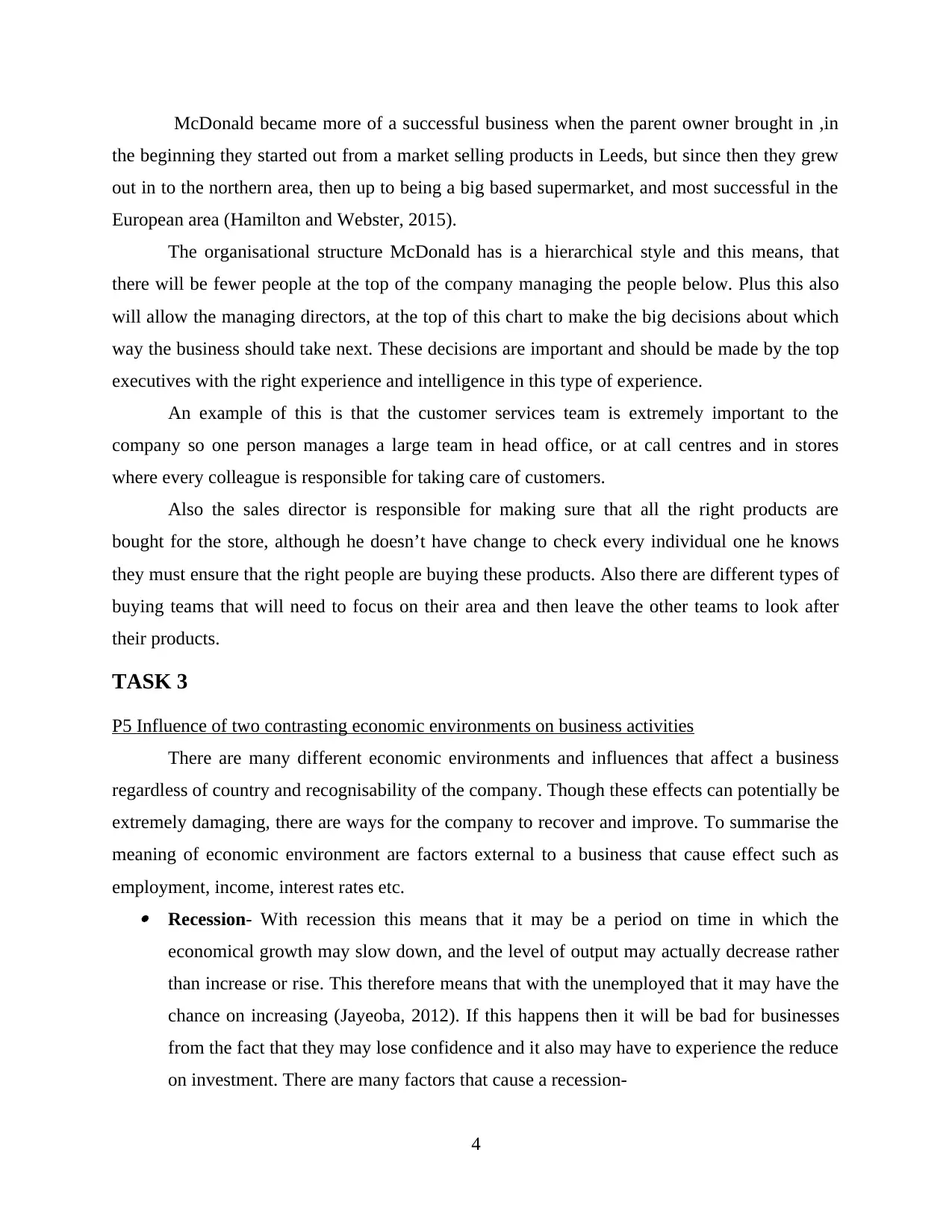
McDonald became more of a successful business when the parent owner brought in ,in
the beginning they started out from a market selling products in Leeds, but since then they grew
out in to the northern area, then up to being a big based supermarket, and most successful in the
European area (Hamilton and Webster, 2015).
The organisational structure McDonald has is a hierarchical style and this means, that
there will be fewer people at the top of the company managing the people below. Plus this also
will allow the managing directors, at the top of this chart to make the big decisions about which
way the business should take next. These decisions are important and should be made by the top
executives with the right experience and intelligence in this type of experience.
An example of this is that the customer services team is extremely important to the
company so one person manages a large team in head office, or at call centres and in stores
where every colleague is responsible for taking care of customers.
Also the sales director is responsible for making sure that all the right products are
bought for the store, although he doesn’t have change to check every individual one he knows
they must ensure that the right people are buying these products. Also there are different types of
buying teams that will need to focus on their area and then leave the other teams to look after
their products.
TASK 3
P5 Influence of two contrasting economic environments on business activities
There are many different economic environments and influences that affect a business
regardless of country and recognisability of the company. Though these effects can potentially be
extremely damaging, there are ways for the company to recover and improve. To summarise the
meaning of economic environment are factors external to a business that cause effect such as
employment, income, interest rates etc. Recession- With recession this means that it may be a period on time in which the
economical growth may slow down, and the level of output may actually decrease rather
than increase or rise. This therefore means that with the unemployed that it may have the
chance on increasing (Jayeoba, 2012). If this happens then it will be bad for businesses
from the fact that they may lose confidence and it also may have to experience the reduce
on investment. There are many factors that cause a recession-
4
the beginning they started out from a market selling products in Leeds, but since then they grew
out in to the northern area, then up to being a big based supermarket, and most successful in the
European area (Hamilton and Webster, 2015).
The organisational structure McDonald has is a hierarchical style and this means, that
there will be fewer people at the top of the company managing the people below. Plus this also
will allow the managing directors, at the top of this chart to make the big decisions about which
way the business should take next. These decisions are important and should be made by the top
executives with the right experience and intelligence in this type of experience.
An example of this is that the customer services team is extremely important to the
company so one person manages a large team in head office, or at call centres and in stores
where every colleague is responsible for taking care of customers.
Also the sales director is responsible for making sure that all the right products are
bought for the store, although he doesn’t have change to check every individual one he knows
they must ensure that the right people are buying these products. Also there are different types of
buying teams that will need to focus on their area and then leave the other teams to look after
their products.
TASK 3
P5 Influence of two contrasting economic environments on business activities
There are many different economic environments and influences that affect a business
regardless of country and recognisability of the company. Though these effects can potentially be
extremely damaging, there are ways for the company to recover and improve. To summarise the
meaning of economic environment are factors external to a business that cause effect such as
employment, income, interest rates etc. Recession- With recession this means that it may be a period on time in which the
economical growth may slow down, and the level of output may actually decrease rather
than increase or rise. This therefore means that with the unemployed that it may have the
chance on increasing (Jayeoba, 2012). If this happens then it will be bad for businesses
from the fact that they may lose confidence and it also may have to experience the reduce
on investment. There are many factors that cause a recession-
4
Paraphrase This Document
Need a fresh take? Get an instant paraphrase of this document with our AI Paraphraser
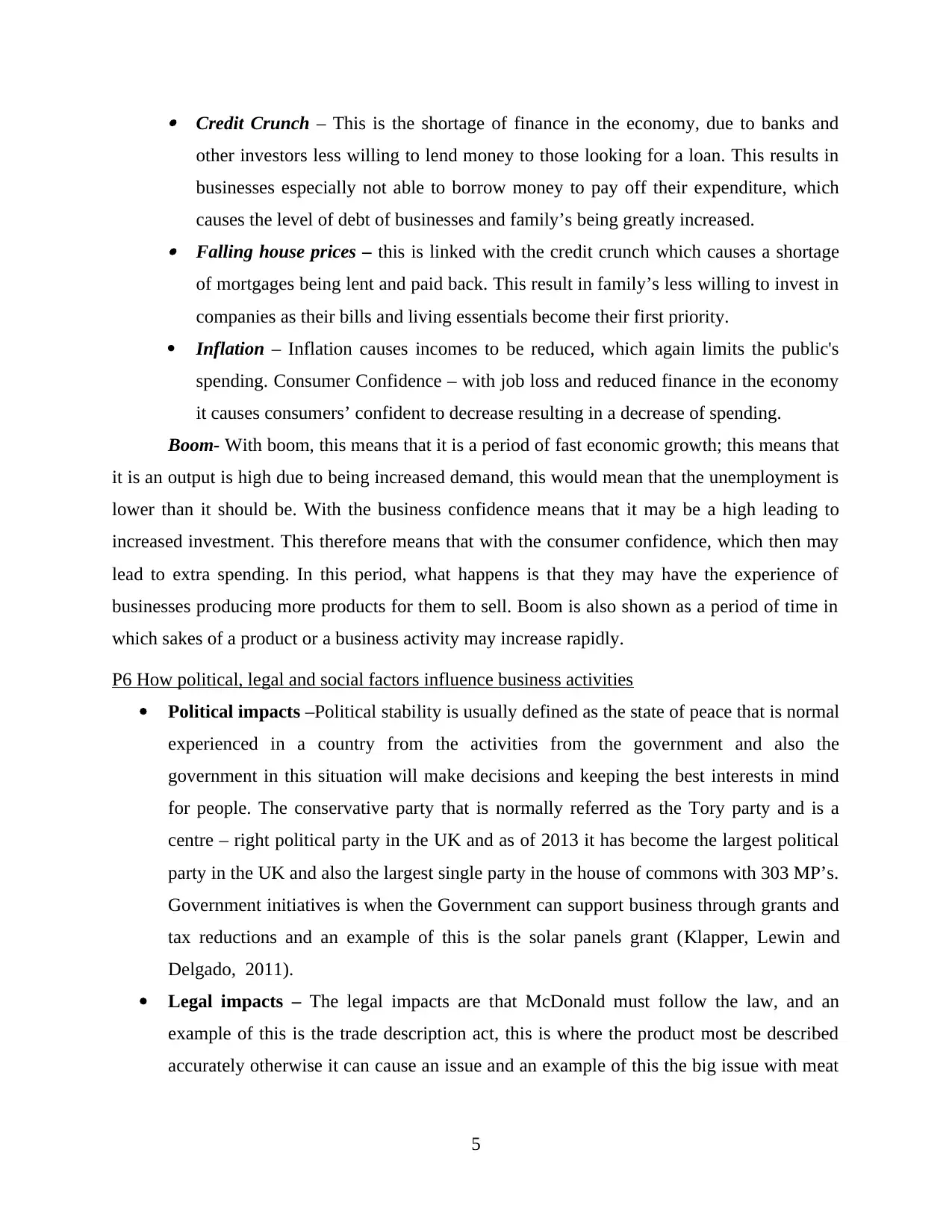
Credit Crunch – This is the shortage of finance in the economy, due to banks and
other investors less willing to lend money to those looking for a loan. This results in
businesses especially not able to borrow money to pay off their expenditure, which
causes the level of debt of businesses and family’s being greatly increased.
Falling house prices – this is linked with the credit crunch which causes a shortage
of mortgages being lent and paid back. This result in family’s less willing to invest in
companies as their bills and living essentials become their first priority.
Inflation – Inflation causes incomes to be reduced, which again limits the public's
spending. Consumer Confidence – with job loss and reduced finance in the economy
it causes consumers’ confident to decrease resulting in a decrease of spending.
Boom- With boom, this means that it is a period of fast economic growth; this means that
it is an output is high due to being increased demand, this would mean that the unemployment is
lower than it should be. With the business confidence means that it may be a high leading to
increased investment. This therefore means that with the consumer confidence, which then may
lead to extra spending. In this period, what happens is that they may have the experience of
businesses producing more products for them to sell. Boom is also shown as a period of time in
which sakes of a product or a business activity may increase rapidly.
P6 How political, legal and social factors influence business activities
Political impacts –Political stability is usually defined as the state of peace that is normal
experienced in a country from the activities from the government and also the
government in this situation will make decisions and keeping the best interests in mind
for people. The conservative party that is normally referred as the Tory party and is a
centre – right political party in the UK and as of 2013 it has become the largest political
party in the UK and also the largest single party in the house of commons with 303 MP’s.
Government initiatives is when the Government can support business through grants and
tax reductions and an example of this is the solar panels grant (Klapper, Lewin and
Delgado, 2011).
Legal impacts – The legal impacts are that McDonald must follow the law, and an
example of this is the trade description act, this is where the product most be described
accurately otherwise it can cause an issue and an example of this the big issue with meat
5
other investors less willing to lend money to those looking for a loan. This results in
businesses especially not able to borrow money to pay off their expenditure, which
causes the level of debt of businesses and family’s being greatly increased.
Falling house prices – this is linked with the credit crunch which causes a shortage
of mortgages being lent and paid back. This result in family’s less willing to invest in
companies as their bills and living essentials become their first priority.
Inflation – Inflation causes incomes to be reduced, which again limits the public's
spending. Consumer Confidence – with job loss and reduced finance in the economy
it causes consumers’ confident to decrease resulting in a decrease of spending.
Boom- With boom, this means that it is a period of fast economic growth; this means that
it is an output is high due to being increased demand, this would mean that the unemployment is
lower than it should be. With the business confidence means that it may be a high leading to
increased investment. This therefore means that with the consumer confidence, which then may
lead to extra spending. In this period, what happens is that they may have the experience of
businesses producing more products for them to sell. Boom is also shown as a period of time in
which sakes of a product or a business activity may increase rapidly.
P6 How political, legal and social factors influence business activities
Political impacts –Political stability is usually defined as the state of peace that is normal
experienced in a country from the activities from the government and also the
government in this situation will make decisions and keeping the best interests in mind
for people. The conservative party that is normally referred as the Tory party and is a
centre – right political party in the UK and as of 2013 it has become the largest political
party in the UK and also the largest single party in the house of commons with 303 MP’s.
Government initiatives is when the Government can support business through grants and
tax reductions and an example of this is the solar panels grant (Klapper, Lewin and
Delgado, 2011).
Legal impacts – The legal impacts are that McDonald must follow the law, and an
example of this is the trade description act, this is where the product most be described
accurately otherwise it can cause an issue and an example of this the big issue with meat
5
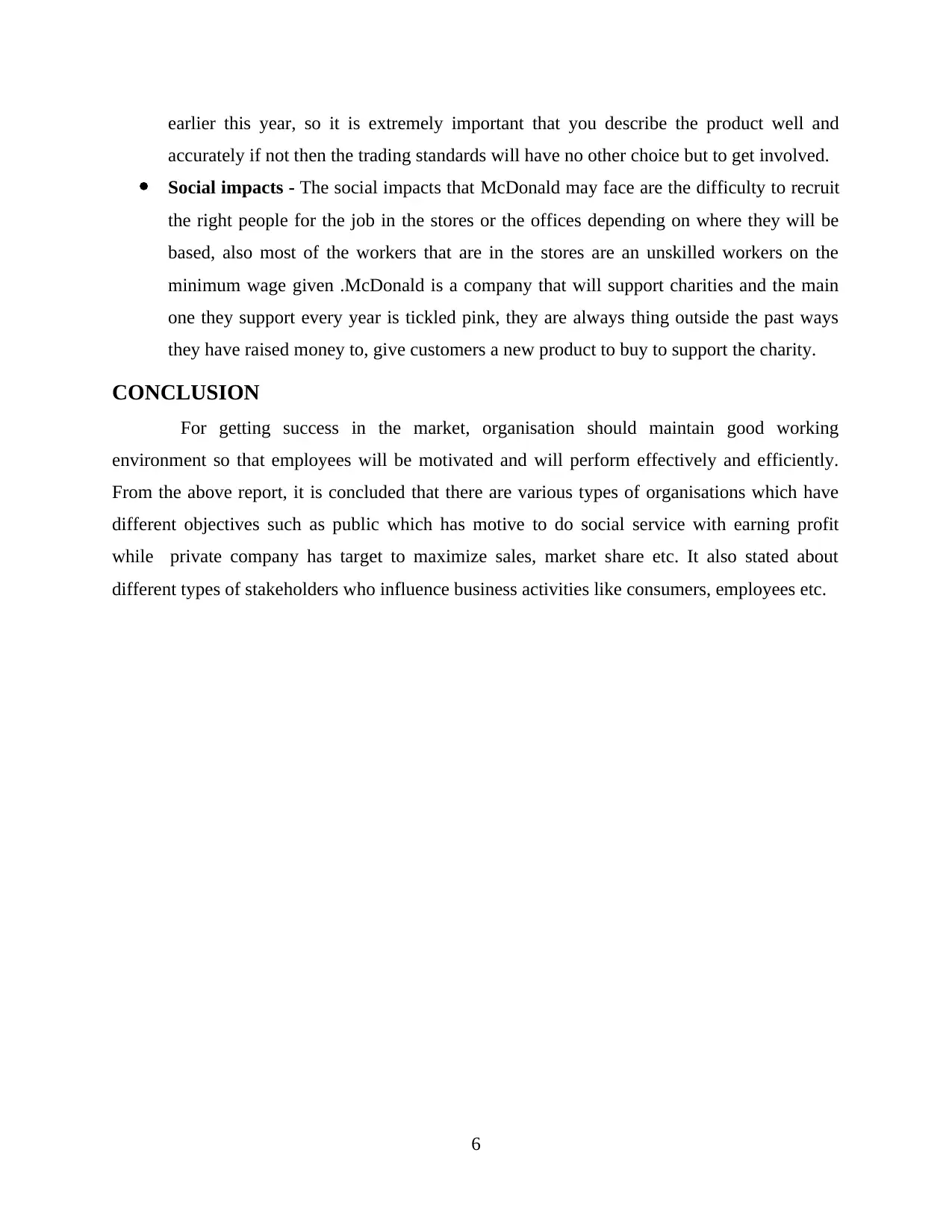
earlier this year, so it is extremely important that you describe the product well and
accurately if not then the trading standards will have no other choice but to get involved.
Social impacts - The social impacts that McDonald may face are the difficulty to recruit
the right people for the job in the stores or the offices depending on where they will be
based, also most of the workers that are in the stores are an unskilled workers on the
minimum wage given .McDonald is a company that will support charities and the main
one they support every year is tickled pink, they are always thing outside the past ways
they have raised money to, give customers a new product to buy to support the charity.
CONCLUSION
For getting success in the market, organisation should maintain good working
environment so that employees will be motivated and will perform effectively and efficiently.
From the above report, it is concluded that there are various types of organisations which have
different objectives such as public which has motive to do social service with earning profit
while private company has target to maximize sales, market share etc. It also stated about
different types of stakeholders who influence business activities like consumers, employees etc.
6
accurately if not then the trading standards will have no other choice but to get involved.
Social impacts - The social impacts that McDonald may face are the difficulty to recruit
the right people for the job in the stores or the offices depending on where they will be
based, also most of the workers that are in the stores are an unskilled workers on the
minimum wage given .McDonald is a company that will support charities and the main
one they support every year is tickled pink, they are always thing outside the past ways
they have raised money to, give customers a new product to buy to support the charity.
CONCLUSION
For getting success in the market, organisation should maintain good working
environment so that employees will be motivated and will perform effectively and efficiently.
From the above report, it is concluded that there are various types of organisations which have
different objectives such as public which has motive to do social service with earning profit
while private company has target to maximize sales, market share etc. It also stated about
different types of stakeholders who influence business activities like consumers, employees etc.
6
⊘ This is a preview!⊘
Do you want full access?
Subscribe today to unlock all pages.

Trusted by 1+ million students worldwide
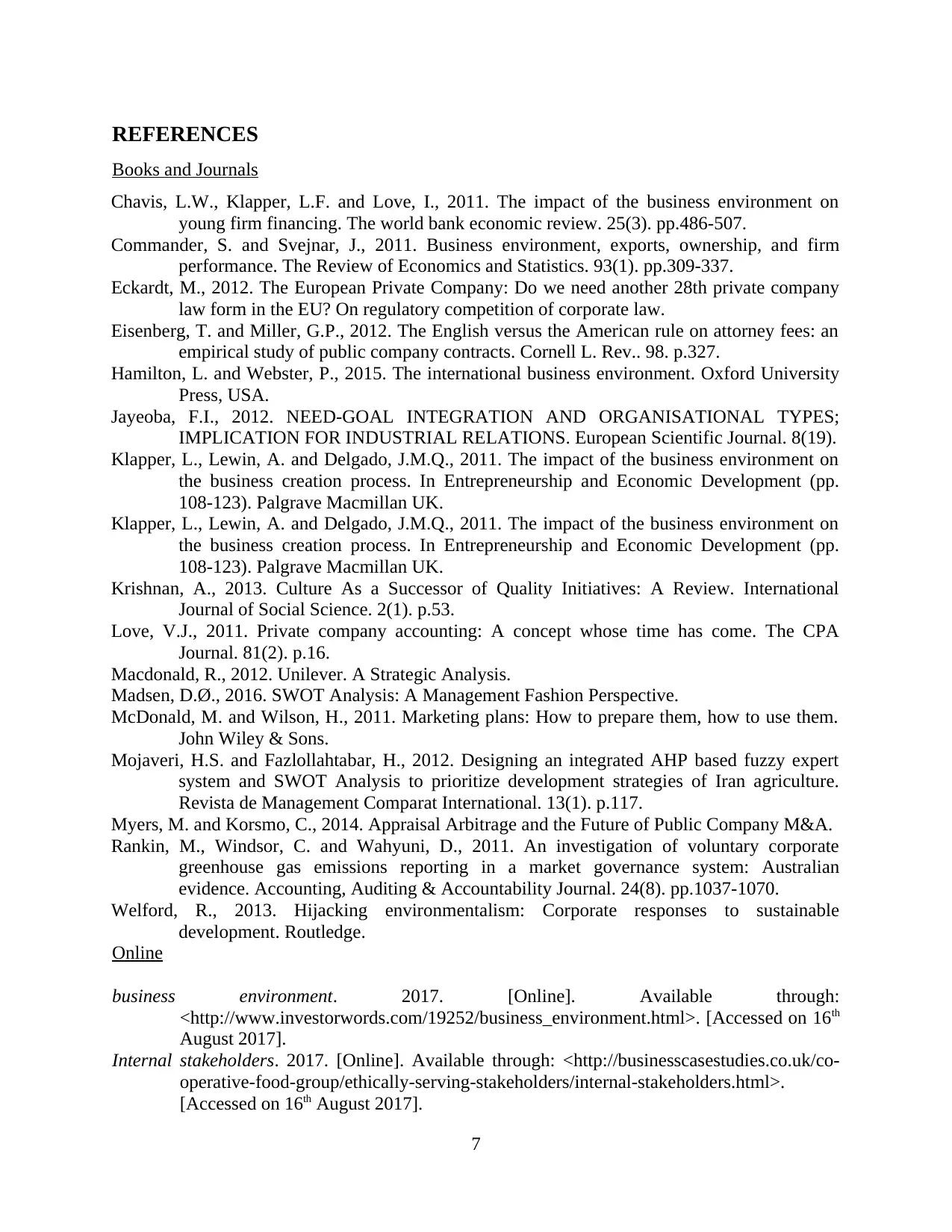
REFERENCES
Books and Journals
Chavis, L.W., Klapper, L.F. and Love, I., 2011. The impact of the business environment on
young firm financing. The world bank economic review. 25(3). pp.486-507.
Commander, S. and Svejnar, J., 2011. Business environment, exports, ownership, and firm
performance. The Review of Economics and Statistics. 93(1). pp.309-337.
Eckardt, M., 2012. The European Private Company: Do we need another 28th private company
law form in the EU? On regulatory competition of corporate law.
Eisenberg, T. and Miller, G.P., 2012. The English versus the American rule on attorney fees: an
empirical study of public company contracts. Cornell L. Rev.. 98. p.327.
Hamilton, L. and Webster, P., 2015. The international business environment. Oxford University
Press, USA.
Jayeoba, F.I., 2012. NEED-GOAL INTEGRATION AND ORGANISATIONAL TYPES;
IMPLICATION FOR INDUSTRIAL RELATIONS. European Scientific Journal. 8(19).
Klapper, L., Lewin, A. and Delgado, J.M.Q., 2011. The impact of the business environment on
the business creation process. In Entrepreneurship and Economic Development (pp.
108-123). Palgrave Macmillan UK.
Klapper, L., Lewin, A. and Delgado, J.M.Q., 2011. The impact of the business environment on
the business creation process. In Entrepreneurship and Economic Development (pp.
108-123). Palgrave Macmillan UK.
Krishnan, A., 2013. Culture As a Successor of Quality Initiatives: A Review. International
Journal of Social Science. 2(1). p.53.
Love, V.J., 2011. Private company accounting: A concept whose time has come. The CPA
Journal. 81(2). p.16.
Macdonald, R., 2012. Unilever. A Strategic Analysis.
Madsen, D.Ø., 2016. SWOT Analysis: A Management Fashion Perspective.
McDonald, M. and Wilson, H., 2011. Marketing plans: How to prepare them, how to use them.
John Wiley & Sons.
Mojaveri, H.S. and Fazlollahtabar, H., 2012. Designing an integrated AHP based fuzzy expert
system and SWOT Analysis to prioritize development strategies of Iran agriculture.
Revista de Management Comparat International. 13(1). p.117.
Myers, M. and Korsmo, C., 2014. Appraisal Arbitrage and the Future of Public Company M&A.
Rankin, M., Windsor, C. and Wahyuni, D., 2011. An investigation of voluntary corporate
greenhouse gas emissions reporting in a market governance system: Australian
evidence. Accounting, Auditing & Accountability Journal. 24(8). pp.1037-1070.
Welford, R., 2013. Hijacking environmentalism: Corporate responses to sustainable
development. Routledge.
Online
business environment. 2017. [Online]. Available through:
<http://www.investorwords.com/19252/business_environment.html>. [Accessed on 16th
August 2017].
Internal stakeholders. 2017. [Online]. Available through: <http://businesscasestudies.co.uk/co-
operative-food-group/ethically-serving-stakeholders/internal-stakeholders.html>.
[Accessed on 16th August 2017].
7
Books and Journals
Chavis, L.W., Klapper, L.F. and Love, I., 2011. The impact of the business environment on
young firm financing. The world bank economic review. 25(3). pp.486-507.
Commander, S. and Svejnar, J., 2011. Business environment, exports, ownership, and firm
performance. The Review of Economics and Statistics. 93(1). pp.309-337.
Eckardt, M., 2012. The European Private Company: Do we need another 28th private company
law form in the EU? On regulatory competition of corporate law.
Eisenberg, T. and Miller, G.P., 2012. The English versus the American rule on attorney fees: an
empirical study of public company contracts. Cornell L. Rev.. 98. p.327.
Hamilton, L. and Webster, P., 2015. The international business environment. Oxford University
Press, USA.
Jayeoba, F.I., 2012. NEED-GOAL INTEGRATION AND ORGANISATIONAL TYPES;
IMPLICATION FOR INDUSTRIAL RELATIONS. European Scientific Journal. 8(19).
Klapper, L., Lewin, A. and Delgado, J.M.Q., 2011. The impact of the business environment on
the business creation process. In Entrepreneurship and Economic Development (pp.
108-123). Palgrave Macmillan UK.
Klapper, L., Lewin, A. and Delgado, J.M.Q., 2011. The impact of the business environment on
the business creation process. In Entrepreneurship and Economic Development (pp.
108-123). Palgrave Macmillan UK.
Krishnan, A., 2013. Culture As a Successor of Quality Initiatives: A Review. International
Journal of Social Science. 2(1). p.53.
Love, V.J., 2011. Private company accounting: A concept whose time has come. The CPA
Journal. 81(2). p.16.
Macdonald, R., 2012. Unilever. A Strategic Analysis.
Madsen, D.Ø., 2016. SWOT Analysis: A Management Fashion Perspective.
McDonald, M. and Wilson, H., 2011. Marketing plans: How to prepare them, how to use them.
John Wiley & Sons.
Mojaveri, H.S. and Fazlollahtabar, H., 2012. Designing an integrated AHP based fuzzy expert
system and SWOT Analysis to prioritize development strategies of Iran agriculture.
Revista de Management Comparat International. 13(1). p.117.
Myers, M. and Korsmo, C., 2014. Appraisal Arbitrage and the Future of Public Company M&A.
Rankin, M., Windsor, C. and Wahyuni, D., 2011. An investigation of voluntary corporate
greenhouse gas emissions reporting in a market governance system: Australian
evidence. Accounting, Auditing & Accountability Journal. 24(8). pp.1037-1070.
Welford, R., 2013. Hijacking environmentalism: Corporate responses to sustainable
development. Routledge.
Online
business environment. 2017. [Online]. Available through:
<http://www.investorwords.com/19252/business_environment.html>. [Accessed on 16th
August 2017].
Internal stakeholders. 2017. [Online]. Available through: <http://businesscasestudies.co.uk/co-
operative-food-group/ethically-serving-stakeholders/internal-stakeholders.html>.
[Accessed on 16th August 2017].
7
1 out of 10
Related Documents
Your All-in-One AI-Powered Toolkit for Academic Success.
+13062052269
info@desklib.com
Available 24*7 on WhatsApp / Email
![[object Object]](/_next/static/media/star-bottom.7253800d.svg)
Unlock your academic potential
Copyright © 2020–2025 A2Z Services. All Rights Reserved. Developed and managed by ZUCOL.





